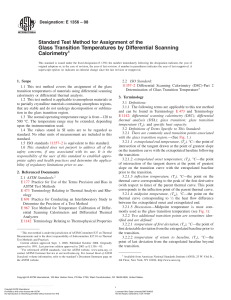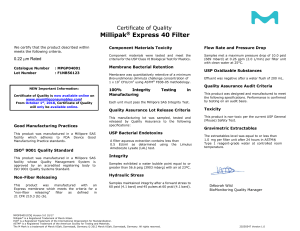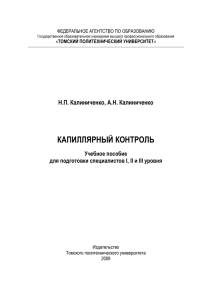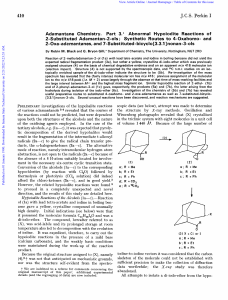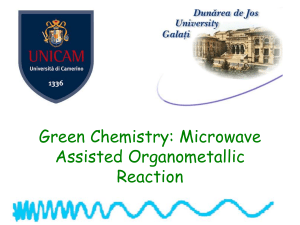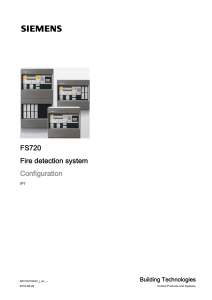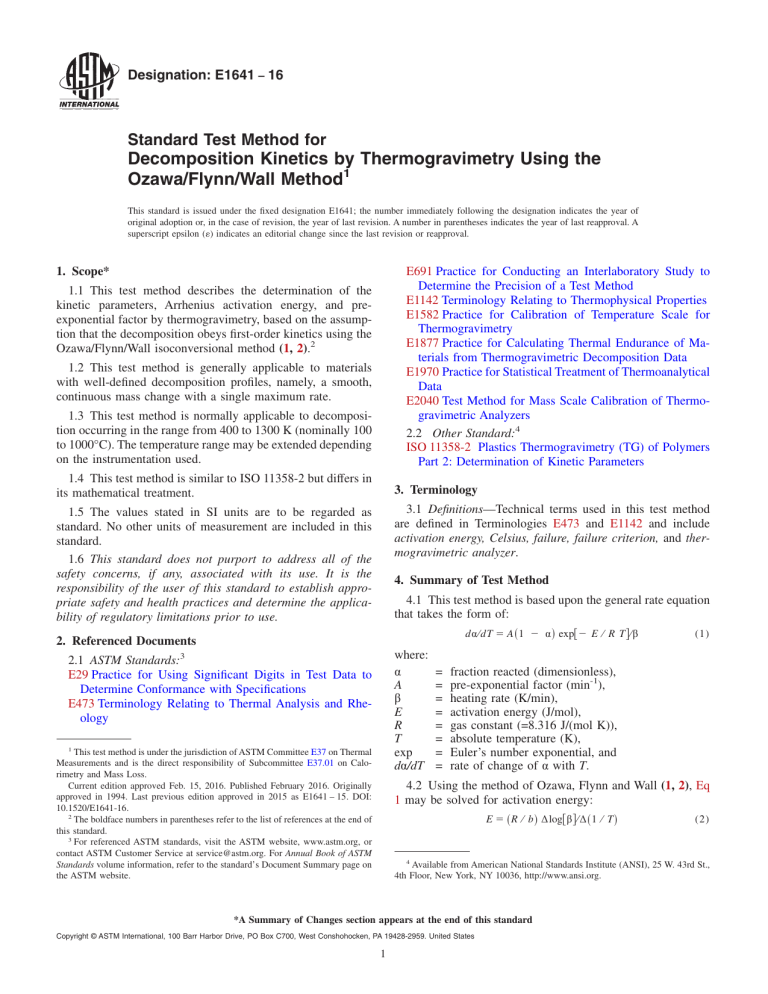
Designation: E1641 − 16 Standard Test Method for Decomposition Kinetics by Thermogravimetry Using the Ozawa/Flynn/Wall Method1 This standard is issued under the fixed designation E1641; the number immediately following the designation indicates the year of original adoption or, in the case of revision, the year of last revision. A number in parentheses indicates the year of last reapproval. A superscript epsilon (´) indicates an editorial change since the last revision or reapproval. E691 Practice for Conducting an Interlaboratory Study to Determine the Precision of a Test Method E1142 Terminology Relating to Thermophysical Properties E1582 Practice for Calibration of Temperature Scale for Thermogravimetry E1877 Practice for Calculating Thermal Endurance of Materials from Thermogravimetric Decomposition Data E1970 Practice for Statistical Treatment of Thermoanalytical Data E2040 Test Method for Mass Scale Calibration of Thermogravimetric Analyzers 2.2 Other Standard:4 ISO 11358-2 Plastics Thermogravimetry (TG) of Polymers Part 2: Determination of Kinetic Parameters 1. Scope* 1.1 This test method describes the determination of the kinetic parameters, Arrhenius activation energy, and preexponential factor by thermogravimetry, based on the assumption that the decomposition obeys first-order kinetics using the Ozawa/Flynn/Wall isoconversional method (1, 2).2 1.2 This test method is generally applicable to materials with well-defined decomposition profiles, namely, a smooth, continuous mass change with a single maximum rate. 1.3 This test method is normally applicable to decomposition occurring in the range from 400 to 1300 K (nominally 100 to 1000°C). The temperature range may be extended depending on the instrumentation used. 1.4 This test method is similar to ISO 11358-2 but differs in its mathematical treatment. 3. Terminology 3.1 Definitions—Technical terms used in this test method are defined in Terminologies E473 and E1142 and include activation energy, Celsius, failure, failure criterion, and thermogravimetric analyzer. 1.5 The values stated in SI units are to be regarded as standard. No other units of measurement are included in this standard. 1.6 This standard does not purport to address all of the safety concerns, if any, associated with its use. It is the responsibility of the user of this standard to establish appropriate safety and health practices and determine the applicability of regulatory limitations prior to use. 4. Summary of Test Method 4.1 This test method is based upon the general rate equation that takes the form of: dα⁄dT 5 A ~ 1 2 α ! exp@ 2 E ⁄ R T # ⁄β 2. Referenced Documents where: α A β E R T exp dα/dT 2.1 ASTM Standards:3 E29 Practice for Using Significant Digits in Test Data to Determine Conformance with Specifications E473 Terminology Relating to Thermal Analysis and Rheology 1 This test method is under the jurisdiction of ASTM Committee E37 on Thermal Measurements and is the direct responsibility of Subcommittee E37.01 on Calorimetry and Mass Loss. Current edition approved Feb. 15, 2016. Published February 2016. Originally approved in 1994. Last previous edition approved in 2015 as E1641 – 15. DOI: 10.1520/E1641-16. 2 The boldface numbers in parentheses refer to the list of references at the end of this standard. 3 For referenced ASTM standards, visit the ASTM website, www.astm.org, or contact ASTM Customer Service at service@astm.org. For Annual Book of ASTM Standards volume information, refer to the standard’s Document Summary page on the ASTM website. = = = = = = = = (1) fraction reacted (dimensionless), pre-exponential factor (min-1), heating rate (K/min), activation energy (J/mol), gas constant (=8.316 J/(mol K)), absolute temperature (K), Euler’s number exponential, and rate of change of α with T. 4.2 Using the method of Ozawa, Flynn and Wall (1, 2), Eq 1 may be solved for activation energy: E 5 ~ R ⁄ b ! ∆log@ β # ⁄∆ ~ 1 ⁄ T ! (2) 4 Available from American National Standards Institute (ANSI), 25 W. 43rd St., 4th Floor, New York, NY 10036, http://www.ansi.org. *A Summary of Changes section appears at the end of this standard Copyright © ASTM International, 100 Barr Harbor Drive, PO Box C700, West Conshohocken, PA 19428-2959. United States 1 E1641 − 16 4.7 For first order reactions (n51 ), the value of the preexponential factor (A) may be determined using Eq 3(4). where: E = the derivative of the Doyle approximation (3) with values tabulated in Table 1. A 5 ~ 2 β R ⁄ E ! ~ ln @ 1 2 α # ! 10a 4.3 Using a point of constant conversion from a series of decomposition curves obtained at different heat rates, ∆log@ β # ⁄∆ ~ 1 2 T ! is obtained by linear regression. where: a = the Doyle approximation value from Table 1. 4.8 This test method consists of heating a series of four or more test specimens, taken from the original sample, each at a different heating rate between 1 and 10 K/min, through their decomposition region. The specimen mass is recorded continuously as a function of temperature. The temperatures for constant conversion are determined from the resultant mass loss curves. The Arrhenius activation energy is then determined from a plot of the logarithm of heating rate versus the reciprocal of the absolute temperature at constant conversion level. 4.4 Assuming an initial value of b50.457, a first approximation of activation energy (Eʹ) is obtained using Eq 2. 4.5 This approximate activation energy is then used to determine a new value of bʹ using Table 1. 4.6 This iterative process is continued until the value of activation energy no longer changes with the next iteration. TABLE 1 Numerical Integration Constants E/RT a b 8 9 10 11 12 13 14 15 16 17 18 19 20 21 22 23 24 25 26 27 28 29 30 31 32 33 34 35 36 37 38 39 40 41 42 43 44 45 46 47 48 49 50 51 52 53 54 55 56 57 58 59 60 5.3699 5.8980 6.4167 6.928 7.433 7.933 8.427 8.918 9.406 9.890 10.372 10.851 11.3277 11.803 12.276 12.747 13.217 13.686 14.153 14.619 15.084 15.547 16.0104 16.472 16.933 17.394 17.853 18.312 18.770 19.228 19.684 20.141 20.5967 21.052 21.507 21.961 22.415 22.868 23.321 23.774 24.226 24.678 25.1295 25.5806 26.0314 26.4820 26.9323 27.3823 27.8319 28.2814 28.7305 29.1794 29.6281 0.5398 0.5281 0.5187 0.511 0.505 0.500 0.494 0.491 0.488 0.484 0.482 0.479 0.4770 0.475 0.473 0.471 0.470 0.469 0.467 0.466 0.465 0.463 0.4629 0.462 0.461 0.461 0.459 0.459 0.458 0.458 0.456 0.456 0.4558 0.455 0.455 0.454 0.454 0.453 0.453 0.453 0.452 0.452 0.4515 0.4511 0.4508 0.4506 0.4503 0.4500 0.4498 0.4495 0.4491 0.4489 0.4487 (3) 4.9 This activation energy may then be used to calculate thermal endurance and an estimate of the lifetime of the material at a certain temperature using Test Method E1877. 5. Significance and Use 5.1 Thermogravimetry provides a rapid method for determining the temperature-decomposition profile of a material. 5.2 This test method can be used for estimating lifetimes of materials, using Test Method E1877 provided that a relationship has been established between the thermal endurance test results and actual lifetime tests. 6. Apparatus 6.1 The essential equipment required to provide the minimum thermogravimetric analytical capability of this test method includes: 6.1.1 A thermobalance, composed of (a) a furnace to provide uniform controlled heating of a specimen at a constant rate within the temperature range from ambient to 1300 K; (b) a temperature sensor to provide an indication of the specimen/ furnace temperature to 60.1 K; (c) an electrobalance to continuously measure the specimen mass with a minimum capacity of 20 mg and a sensitivity of 650 µg; and (d) a means of sustaining the specimen/container under atmospheric control of an inert or reactive purge gas of 99.99 % purity at a rate of 20 to 50 6 5 mL ⁄min. 6.1.2 A temperature controller, capable of executing a specific temperature program by operating the furnace between selected temperature limits at a rate of temperature change between 1 and 10 K/min to within 60.1 K/min. NOTE 1—The precision of results is strongly dependent upon the precision of the heating rate; the greater the heating rate precision, the greater the precision of results. The precision described here should be considered to be the minimum suitable for this test. 6.1.3 A data collection device, to provide a means of acquiring, storing, and displaying measured or calculated signals, or both. The minimum output signals required for this test method are mass, temperature, and time. 6.1.4 Containers (pans, crucibles, and so forth) which are inert to the specimen and that will remain dimensionally stable over the temperature range from ambient to 1300 K. 2 E1641 − 16 6.2 High-Purity (99.99 %) Nitrogen Supply, for purge gas. 9. Calibration NOTE 2—Other atmospheres may be used but shall be reported. 9.1 Prepare the thermogravimetric analyzer using any procedures described in the manufacturer’s Operations manual. 6.3 Auxiliary apparatus considered necessary or useful in conducting this test method include: 6.3.1 Cryogenic Mill to grind or mill test specimens to a fine powder at temperatures below –173 K (–100°C). 9.2 Place the temperature sensor within 2 mm of the outside of the specimen holder. Care must be taken to ensure that the specimen holder is not touched in any way by the sensor and that it is not moved after temperature calibration. 7. Precautions 9.3 Maintain a constant flow rate of purge gas in the range from 20 to 50 mL/min throughout the experiment. 7.1 It is essential that the samples be representative since milligram quantities of specimen are to be used. NOTE 5—In the case of samples that may be sensitive to oxidative degradation, it will be necessary to maintain inert gas purging for a time sufficient to ensure that all residual oxygen is removed from the system prior to the start of the temperature program. It may be necessary to evacuate the system prior to initiating inert gas purging for some instruments. 7.2 The value of the calculated activation energy is independent of reaction order in the early stages of decomposition. This assumption does not hold for the later stages and shall be used with caution. An upper limit of 10 % decomposition is suggested. It is strongly suggested that calculations be made at several different levels of decomposition, for example, 5, 10, 15, and 20 %. Variations in the results among these determinations could indicate the inapplicability of one of them. For instance, volatile, low-level impurities would affect the results of the lowest conversion determination more than those at higher conversions. Consistent results for all conversions validate the method for the range of conversions examined. 9.4 Calibrate the instrument furnace temperature in accordance with the calibration procedure in Practice E1582 using the same heating rate, purge gas, and flow rate to be used for the specimens. The temperature calibration shall be performed both prior to every change in heating rate and at that heating rate. 9.5 Calibrate the mass signal using Test Method E2040. 7.3 Toxic or corrosive effluents, or both, may be released during the heating process and may be harmful to the personnel or apparatus. 10. Procedure 8. Sampling NOTE 6—Other specimen sizes may be used but shall be indicated in the report. NOTE 7—The specimen holder should be tared in the fully assembled system, with the purge gas flowing. NOTE 8—Powdered or granular specimens should be distributed evenly over the specimen holder so as to maximize the exposed surface. A one-grain thick layer would be optimal. 10.1 Place 3 6 1 mg of the specimen under test into a clean, tared instrument specimen holder. 8.1 Powdered or granular specimens that have a high surface-to-volume ratio, are preferred, although films, fibers, and fabrics may be used providing that care is taken to make all of the specimens uniform in size and shape. Under circumstances in which material parts are available, the specimens should be prepared by filing or rasping the part. All specimens should be mixed thoroughly prior to sampling if possible, and they should be sampled by removing portions from various parts of the container. These portions should in turn be combined and mixed well to ensure a representative specimen for the determination. 10.2 Select an equilibrium temperature based upon the heating rate and known decomposition first-deviation-frombaseline temperature of the specimen, where the equilibrium temperature equals the decomposition temperature – (10 min × heating rate). If the percentage mass loss is to be recorded, establish zero percent loss at this time. NOTE 9—If zero percent mass loss is established at the time at which the specimen is placed into the instrument, the specimen mass at the equilibration temperature can be greater than 100 % due to buoyancy effects. A blank should be run for accurate determination of the buoyancy effect throughout the temperature range of the experiment. The blank can be a piece of platinum of approximately the same volume as the specimen. The balance drift at any temperature can be determined in this manner. NOTE 3—Care should be exercised during sample preparation to avoid contamination. NOTE 4—The specimen size and surface-to-volume ratio are known to affect the results of this test. A narrow range of specimen sizes should be used, as noted in 10.1. Uniformity in particle size can be achieved, without the loss of volatiles, by using a cryogenic mill to grind the sample to a fine powder. To prevent the condensation of moisture, the mill should be opened only after returning fully to ambient temperature, or the operation should be performed in a glove box filled with dry gas. 10.3 Heat the specimen at a constant rate through the decomposition profile until a constant mass is obtained or the temperature is well beyond the useful temperature range of the material tested. Record the accompanying thermal curve, with mass or percentage mass loss displayed on the ordinate and specimen temperature on the abscissa. 8.2 In the absence of other information, the samples are assumed to be analyzed as received except for the mechanical treatment noted in 8.1. If some heat treatment, such as drying, is applied to the sample prior to analysis, this treatment and any resulting mass loss must be noted in the report. 10.4 Once the decomposition of the test specimen is complete, cool the instrument to room temperature, remove, clean, and replace the specimen holder, and re-tare the instrument in preparation for additional experiments. Use the same specimen holder for the entire series of runs to eliminate buoyancy problems. 8.3 Certain materials require more sophisticated conditioning, such as maintaining the sample at a specified room temperature and relative humidity for an extended period of time. Such conditioning may be conducted, but procedural details shall be included in the report. 3 E1641 − 16 FIG. 1 Examples of Mass Loss Curves at the Following Heating Rates: 1°C/min, 2°C/min, 5°C/min, 10°C/min FIG. 2 Arrhenius Plot of Heating Rate, Temperature of Constant Conversion Data 1. The temperature corresponding to other conversion levels (not greater than 20 % and preferably less than 10 %) may be used in the determination, but it must be noted in the report. 10.5 Repeat the procedures described in 10.1 – 10.4 at three additional heating rates covering the range from 1 to 10 K/min. NOTE 10—Other heating rates, and more than four, may be used but shall be noted in the report. NOTE 11—The use of heating rates greater than 10 K/min affects both the precision of the temperature measurement and the kinetics of the decomposition. Diffusion of volatiles from the sample may become the rate-controlling process at high heating rates. NOTE 13—These calculations are simplified if the percent mass loss rather than actual mass is recorded on the ordinate. NOTE 14—The value is determined from the difference of the initial and final sample conversion, with the initial mass taken as the mass at the equilibration temperature and the final mass taken once the plateau has been reached at the end of weight loss. For example, if the initial mass is 100.3 % and the final mass is 80 %, 100 % decomposition corresponds to (100.3 to 80.0) or 20.3 % mass loss. Thus, 5 % decomposition occurs at (0.05 × 20.3) or 1.02 % mass loss, which occurs on the ordinate at 99.3 % (100.3 % − 1.02 % = 99.28 %). 11. Calculation 11.1 Select some mass loss (conversion) as the failure criterion. 11.3 Display the logarithm of the heating rate expressed in K/min against the reciprocal of the absolute temperature in K at which the conversion level (failure criterion), selected in 11.1, was reached. A straight line, similar to that in Fig. 2, should result. This test procedure is not applicable if the curve is nonlinear. NOTE 12—5 % mass loss is commonly selected as the failure criterion. Other values may be used but shall be reported. 11.2 From each of the thermal curves obtained in 10.1 – 10.5, determine the absolute temperature at constant conversion, α, for each of the constant conversion values to be used in the calculations as noted in 7.2. For example, see Fig. 4 E1641 − 16 NOTE 15—An apparent nonlinearity may result from erroneous determinations. It is recommended that any nonlinear points be repeated for verification. E 5 8.314 J/ ~ mol K ! 3 ~ 216 394 K ! 3 ~ 0.457! 5 298 249 J/mol 11.11.3 Calculating the value of E'/RTc: E'/RTc 5 @ 298 249 J/mol# / @ 8.314 J/ ~ mol 3 K ! 3 783 K # 5 45.81 11.4 Using the linear regression fit a straight line (see Practice E1970) to these data without weighing factors, and determine the slope (m) and its standard deviation (δm): 11.11.4 From Table 1 for E/RT = 45.81, b = 0.453. 11.11.5 Reiterating yields: m 5 ∆ ~ logβ ! /∆ ~ 1/T ! (4) NOTE 16—If the values obtained from this test method are to be used in Test Method E1877, an estimation of the uncertainty for activation energy (E) and preexponential factor (A) is required. These uncertainties may be derived from the uncertainty in the slope value of m 5∆ ~ log β ! ⁄∆ ~ 1 ⁄ T ! . If the calculation tool used to obtain the slope of the straight line provides an estimation of uncertainty in the determined slope (δm), record it. Otherwise, the uncertainty in the slope may be obtained using the procedure in Appendix X1. E E/RTc b E' b a α Tc 300 882 J/mol 46.22 0.453 300 882 J ⁄mol 11.12 Example calculation for pre-exponential factor (A): 11.5 The following definitions apply to 11.3 – 11.10: β' = = = = β' = 5 K/min α = 0.05 = heating rate nearest the midpoint of the experimental heating rates, K/min, = logarithm of the approximation derivative in K/min (known as the Doyle approximation) (from Table 1 (use b50.457 K⁄min on first iteration), = logarithm of the approximation integral (known as the Doyle approximation) taken from Table 1, = fraction reacted (dimensionless), and = temperature for point of constant conversion for β', K. 11.12.1 From 11.10 and Table 1: E = 300 882 J/mol a = 23.321 11.6 Calculate an estimation of the activation energy using Eq 2 (1, 5), making use of the value of ∆ ~ log β ! ⁄∆ ~ 1 ⁄ T ! determined in 11.4 and a value of b50.457 K⁄min in this first iteration. 11.12.2 Using Eq 3: A 5 2~5 K/min! 3 ~ 8.314 J/ ~ mol K!! 3 ~ ln @ 1 2 0.05# ! 3 ~ 1023.321! ⁄ ~ 300 882 J/mol! 11.7 Calculate the value for E/RTc, where Tc = the temperature at constant conversion for the heating rate closest to the midpoint of the experimental heating rates. A 5 2~5 K/min! 3 ~ 8.314! 3 ~ 2 0.05129! 3 ~ 1023.321! ⁄ ~ 300 882! A,min21 5 100.699 3 100.910 3 1021.290 3 1023.321 3 1025.478 5 1018.162 log@ A , min21 # 5 18.162→ln@ A , min21 # 5 41.827 NOTE 18—When recording direct measurements, all digits known, plus one digit, which may be uncertain due to estimation, shall be recorded. When data is obtained from a digital display or printout from an instrument, all available digits shall be recorded. When calculating results, retain all available significant figures rounding only at the final results. Final results shall be rounded to the least significant figure whose significance is not greater that 0.5 times nor less than 0.05 times the standard deviation (see Practice E29). 11.8 Using the value for Ee/RTc obtained in 11.7, obtain a new estimation of b from Table 1. Resubmit this value of b to Eq 2. 11.9 Repeat 11.6 and 11.7 until the value for the activation energy changes by less than 1 %. This refined value, E, is reported as the Arrhenius activation energy. 11.10 Select the mass loss curve for the heating rate nearest the midpoint of the experimental heating rates, and calculate the pre-exponential factor, A, using Eq 3 (4) and the value of the exponent, a, obtained from Table 1 for the refined value of Ee/RTc determined in 11.9. 12. Report 12.1 Report the following information: 12.1.1 Designation of the material under test, including the name of the manufacturer, lot number, and chemical composition when known. 12.1.2 Description of the thermogravimetric analyzer used. 12.1.3 Purge gas, flow rate, and composition. 12.1.4 Specimen masses, temperature range, failure criterion, and heating rates used. 12.1.5 Determined Arrhenius activation energy, E, relative standard deviation of activation energy, δE/E, and preexponential factor, A, (or ln[A]) and its standard deviation, δln[A]/ln[A]. 12.1.6 The specific dated version of this test method. NOTE 17—This mathematical treatment to solve for E and A has been tailored specifically to make it possible to perform by hand. Commercial kinetics software may use other numerical methods of integrating the general differential form of the rate equation (the Flynn and Wall equations) and solving for the parameters. The interim values Ea, a, and b, which are part of the numerical iteration, are thus not reported. 11.11 Example calculation for E (from Fig. 2): T r 5 510°C=783 K, and ∆ ~ logβ ! /∆ ~ 1/T ! 5 @ 1.000 2 0.000# / @ 0.001258 2 0.001319# 5 216 394 K 13. Precision and Bias 11.11.1 As the first estimation: 13.1 The precision and bias of this test method were determined in an interlaboratory test (ILT) on powdered poly(tetrafluoroethylene) (PTFE) conducted in 1988 – 1989. b 5 0.457 11.11.2 Using Eq 2: 5 E1641 − 16 13.3.1 An estimation of the bias is obtained by comparing the mean values obtained in this study with values obtained from the literature. 13.3.2 The mean activation energy obtained in this study was 327 kJ/mol. The mean natural logarithm of the preexponential factor (1/min) obtained was 45.7. 13.3.3 Mean values and standard deviation for activation energy and natural logarithm of the pre-exponential factor taken from the literature (6-11) were E = 320 6 24 kJ ⁄mol and ln[–A, min-1] = 45.6 6 4.1, which are non-weighted average values from six independent references. 13.3.4 The values for activation energy and natural logarithm of pre-exponential factor obtained in this study are not statistically different from those obtained from the literature. This indicates an absence of significant bias. 13.3.5 Information supporting the precision and bias information below is available on loan from ASTM Headquarters.5 Nine laboratories using thermogravimetric analyzers from two manufacturers, participated in the ILT. Each laboratory reported two sets of data with each set containing data from four heating rates between 1 and 10 K/min. Temperature calibration was made using nickel and perkalloy magnetic reference materials that bracketed the decomposition region of PTFE. The kinetic constants were determined for 5 % decomposition (failure criterion). The results were statistically treated by Test Method E691. 13.2 Precision: 13.2.1 Within laboratory variability may be described using the repeatability value (r) obtained by multiplying the standard deviation by 2.8. The repeatability value estimates the 95 % confidence limit. 13.2.1.1 Repeatability values of 26 kJ/mol and 4.2 were obtained for the activation energy and natural logarithm of the pre-exponential factor (1/min), respectively. 13.2.2 The between laboratory variability may be described using the reproducibility value (R) obtained by multiplying the standard deviation by 2.8. The reproducibility value estimates the 95 % confidence limit. 13.2.2.1 Reproducibility values of 45 kJ/mol and 8.2 were obtained for the activation energy and natural logarithm of the pre-exponential factor (1/min), respectively. 14. Keywords 14.1 activation energy; pre-exponential factor; failure; failure criterion; kinetic parameters; thermal analysis; thermal decomposition; thermogravimetric analysis 5 Supporting data have been filed at ASTM International Headquarters and may be obtained by requesting Research Report RR:E37-1021 and Research Report RR:E37-1022. Contact ASTM Customer Service at service@astm.org. 13.3 Bias: APPENDIX (Nonmandatory Information) X1. ESTIMATING THE UNCERTAINTY IN THE ACTIVATION ENERGY AND PRE-EXPONENTIAL FACTOR X1.1 The imprecision in activation energy (δE) is related to the imprecision in the determination of the slope value m = ∆ log β/∆ (1/T) obtained in 11.4. This relationship is given by: x δm m n xI yi Σ δyi δm/m 5 δE/E X1.2 The uncertainty in the slope of a straight line (see Test Method E1970). δm 5 F~ nΣ ~ δy i ! 2 n 2 2 ! @ nΣx i 2 2 ~ Σx i ! 2 # G 1/2 = = = = = = = = 1/T, uncertainty in the value of m, ∆(log β)/∆(1/T), number of individual sets of x and y data, an individual x data point, an individual y data point, mathematical function equivalent to “sum of all,” the uncertainty in an individual y value and is given by, and δyi = yi − (m × xi + b) X1.3 The uncertainties in the pre-exponential factor (δA) or its natural logarithm (δ ln A) are related to the uncertainty in the activation energy by: where: y = ∆log β, δlnf A g 5 δA⁄A 5 f s δ β ⁄ β d 2 1 s δ E ⁄ E d 2 1 δ s 1 2 α d ⁄ s 1 2 α d 1 s 2.303 δ a d 2 g 1⁄2 6 E1641 − 16 REFERENCES Degradation of Tetrafluoroethylene and Hydrofluoroethylene Polymers in a Vacuum,” Journal of Research of the National Bureau of Standards, Vol 51, No. 6, 1953, pp. 327–333. (8) Cox, J.M., Wright, B.A., and Wright, W.W., “Thermal Degradation of Fluorine-Containing Polymers. Part. I. Degradation in Vacuum,” Journal of Applied Polymer Science, Vol 8, 1964, pp. 2935–2950. (9) Siegle, J.C., Mures, L.T., Lin, Tung-Po, and Larson, H.A., “The Molecular Structure of Perfluorocarbon Polymers. II. Pyrolysis of Polytetrafluoroethylene,” Journal of Polymer Science, Vol A2, 1964, pp. 391–404. (10) Jellenek, H.H.G., and Kachi, H., “Thermal Degradation of Polytetrafluoroethylene in a Closed System,” Makromolekulare ChemieMacromolecular Chemistry And Physics, Vol 85, 1965, pp. 1–5. (11) Jellenek, H.H.G., and Kachi, H., “Thermal Degradation of Polytetrafluoroethylene in a Closed System. Effect of the Nature of the Surface of the Reaction Vessel Wall,” Polymer Engineering and Science, Vol 5, 1965, pp. 200–203. (1) Flynn, J.H., and Wall, L.A., “A Quick, Direct Method for the Determination of Activation Energy from Thermogravimetric Data,” Polymer Letters, Vol 4, 1966, pp. 323–328. (2) Ozawa, T., “A New Method of Analyzing Thermogravimetric Data,” Bulletin of the Chemical Society of Japan, Vol 88, 1965, pp. 1881–1886. (3) Doyle, C.D., “Kinetic Analysis of Thermogravimetric Data,” Journal of Applied Polymer Science, Vol 5, 1961, pp. 285–292. (4) Flynn, J.H., and Wall, L.A., “General Treatment of the Thermogravimetry of Polymers,” Journal of Research of the National Bureau of Standards, Vol 70A, 1966, pp. 487–523. (5) Flynn, J.H., “The isoconversional Method for Determination of Energy of Activation at Constant Heating Rate,” Journal of Thermal Analysis, Vol 27, 1983, pp. 95–102. (6) Fuoss, R.M., Sayler, I.O., and Wilson, H.S., “Evaluation of Rate Constants from Thermogravimetric Data,” Journal of Polymer Science, Vol A2, 1964, pp. 3137–3151. (7) Madorsky, S.L., Hart, V.E., Straus, S., and Sedlak, V.A., “Thermal SUMMARY OF CHANGES Committee E37 has identified the location of selected changes to this standard since the last issue (E1641 – 15) that may impact the use of this standard. (Approved Feb. 15, 2016.) (1) Revised 10.2, 11.5, and 11.6. ASTM International takes no position respecting the validity of any patent rights asserted in connection with any item mentioned in this standard. Users of this standard are expressly advised that determination of the validity of any such patent rights, and the risk of infringement of such rights, are entirely their own responsibility. This standard is subject to revision at any time by the responsible technical committee and must be reviewed every five years and if not revised, either reapproved or withdrawn. Your comments are invited either for revision of this standard or for additional standards and should be addressed to ASTM International Headquarters. Your comments will receive careful consideration at a meeting of the responsible technical committee, which you may attend. If you feel that your comments have not received a fair hearing you should make your views known to the ASTM Committee on Standards, at the address shown below. This standard is copyrighted by ASTM International, 100 Barr Harbor Drive, PO Box C700, West Conshohocken, PA 19428-2959, United States. Individual reprints (single or multiple copies) of this standard may be obtained by contacting ASTM at the above address or at 610-832-9585 (phone), 610-832-9555 (fax), or service@astm.org (e-mail); or through the ASTM website (www.astm.org). Permission rights to photocopy the standard may also be secured from the Copyright Clearance Center, 222 Rosewood Drive, Danvers, MA 01923, Tel: (978) 646-2600; http://www.copyright.com/ 7
